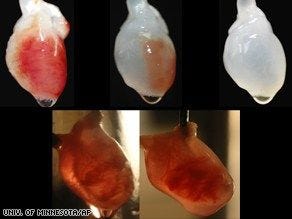A beating heart created in a lab
Scientists have taken the next step in biological science! They have created a beating heart “from scratch” so to say. As the video below says, the researcher here gave nature its tools and let it do the rest. It was kind of an interesting way to do it.
This could create infinite possibilities for human longevity! Now human organs may have a chance to be created afresh rather than just be transplanted.
Here is how it worked:
Rather than building a heart from scratch, which has often been mentioned as possible use for stem cells, this procedure takes a heart and breaks it down to the outermost shell. It’s similar to taking a house and gutting it, then rebuilding everything inside. In the human version, the patient’s own cells would be used.
“We took a rat heart and used soap to wash out the cells of the heart,” said Doris Taylor, director of the Center for Cardiovascular Repair, Medtronic Bakken professor of medicine and physiology and lead author of the study.
The process is called “decelluarization.” To do this, Taylor and her team hung up the heart from a dead rat, introduced a regular soap solution into the top of the organ, and let gravity do the work. The soap moved through the heart’s blood vessels, dissolving existing cells, which dropped out of the bottom. This process was repeated until only the outermost casing of the heart was left, resulting in a “white, almost gelatin-looking heart,” Taylor explained. This would be the equivalent of the gutted house.
The rebuilding started with injecting new heart cells, in this case cells from baby lab rats, and pumping them through the heart. By treating the cells as heart cells would be treated and using a pacemaker to help them learn how to pump, they grew into a heart that could pump — essentially rebuilding the organ’s interior.




